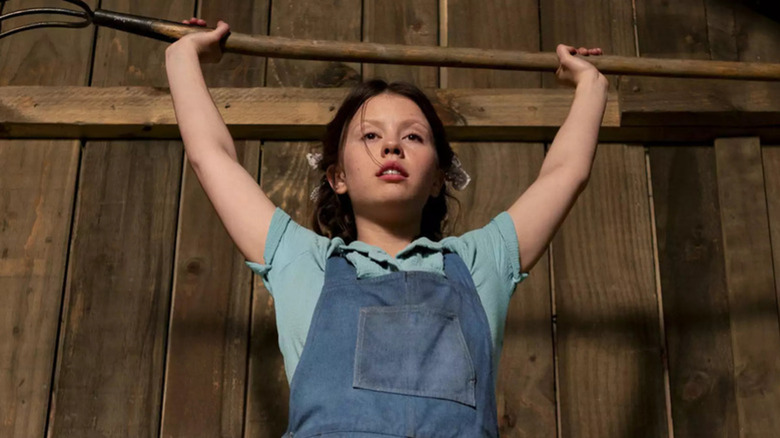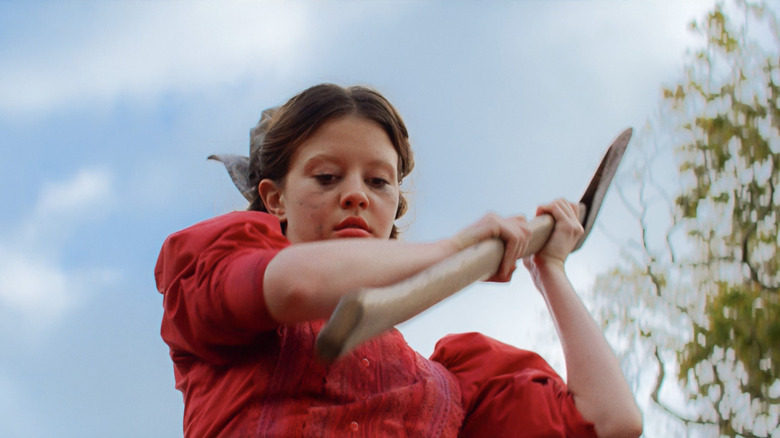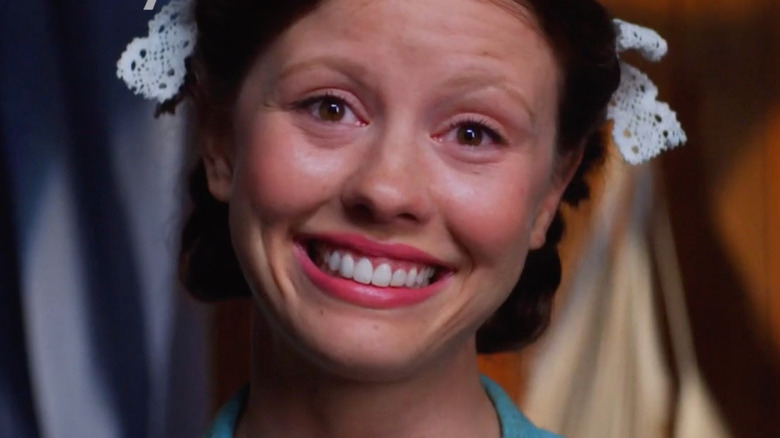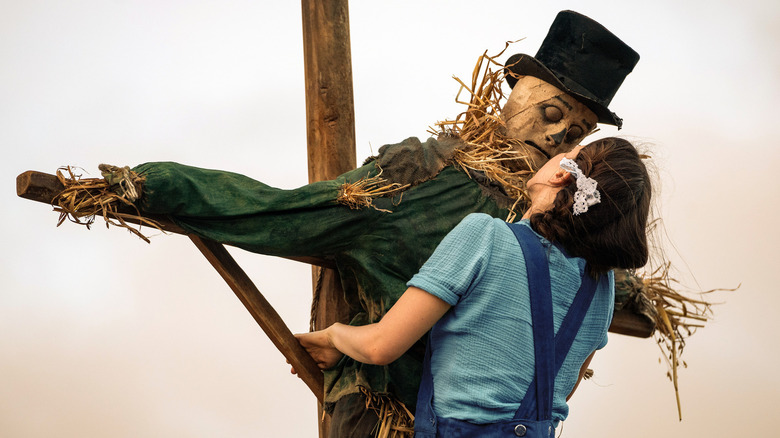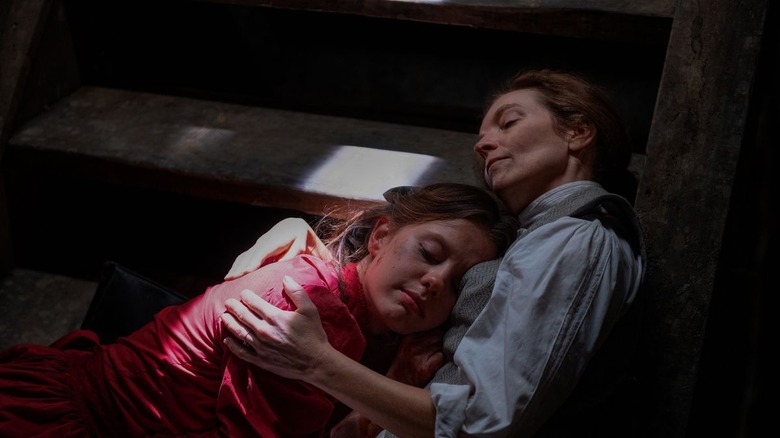How Ti West's Pearl Remakes The Wizard Of Oz As A Horror Movie
Ti West's "Pearl," a prequel to his subversive slasher "X," is one of the best horror movies in recent years. Mia Goth's spellbinding performance as a lonely, sadistic farmer's daughter with big dreams carries the film. Both "Pearl" and "X," as well as the upcoming third film in the trilogy, "MaXXXine," honor the film and pornography industries and study the allure of stardom through a celluloid aesthetic that captures a particular era in cinema history.
"X" was Ti West's homage to the schlocky 1970s grindhouse movies and the available snippet of "MaXXXine" seems to capture the grainy VHS artificiality of the 1980s. "Pearl," meanwhile, is like looking at classic Hollywood through a funhouse mirror. Ti West tells Filmmaker Magazine that he used the same dazzling Technicolor palette as "The Wizard of Oz." These striking colors are a visual expression of Pearl's romantic fantasies yet they feel uncanny as if something sinister lurks beneath.
Mia Goth watched "The Wizard of Oz" as a "palate cleanser" to get into the mindset of a young Pearl. The classic film's dreamy innocence and sense of wonder helped her shift from the vengeful, elder Pearl to the sheltered girl who aspires to be a dancer in moving pictures. "Pearl" refracts the beloved fantasy of "The Wizard of Oz" through numerous visual and thematic references.
The use of vibrant technicolor
"Pearl" recreates the bold, surrealistic look of Technicolor films such as "The Wizard of Oz" by using technology to amplify the primary colors in a shot (via GQ). The opening and end credit sequences match this old-fashioned style, creating a heightened reality that makes "Pearl" feel as if it were truly ripped out of the past. It's an explosion of vibrant color with reds as sparkling as Dorothy's ruby slippers and greens as radiant as Emerald City.
In "The Wizard of Oz," the rainbow colors convey the magic of Oz and how it juxtaposes the black and white blandness of Kansas. The vivid hues in "Pearl" are a manifestation of her cinematic ambitions; Pearl wants her life to feel as bold and epic as what she sees on the silver screen. Towards the end of the film, more scenes take place in dark spaces to symbolize Pearl's isolation and anger growing stronger and her dreams slipping further away.
The pastoral landscapes in "Pearl" immediately recall the farm from the opening of "The Wizard of Oz": the animals, wide fields, and thatched barns. Pearl's costuming evokes Dorothy with her bright blue overalls and hair in braids with ribbons. She looks like the same idealistic farm girl, but this wholesome exterior covers a violent malevolence. In other scenes, Pearl dons a top hat that she steals from a scarecrow. When she determinedly zips across the cornfields on her bike, she resembles the mean Miss Gulch.
Dorothy and Pearl dream of a life over the rainbow
Trapped on her family's secluded farm, Pearl must tend to her ailing father under the overbearing eye of her strict mother. In her astounding ten-minute monologue, we learn that Pearl married Howard to escape from the farm, but he ended up wanting to stay there. When he went overseas to fight in World War I and the Spanish flu took hold in America, Pearl had to help her mother and she has been suffering ever since. Feeling trapped and restless, Pearl longs for a glamorous life like the ones she sees in the pictures.
Dorothy in "The Wizard of Oz" is also fed up with her rustic environment, yearning to escape from the sniveling hogs, clucking chickens, and fearsome Miss Gulch who threatens to harm her dog, Toto. She sings of this desire in the iconic "Somewhere Over the Rainbow." Both Dorothy and Pearl imagine a magical life for themselves that seems unattainable.
Like most classic Hollywood films, "The Wizard of Oz" ends on an uplifting note where Dorothy learns that, if you work hard enough, your dreams can come true and that her home is a comforting place. Pearl, on the other hand, is resigned to a miserable life on the farm. The end credits scene is a twisted version of the luminous close-ups of Dorothy in "The Wizard of Oz." For several excruciating minutes, Pearl grits her teeth in a cartoonishly wide grin to try and seem happy that Howard is home. She is just as rosy-cheeked and red-lipped as the sweet Judy Garland, but you can see the cracks in her mental state as her smile wavers and her eyes well with tears.
Different versions of the Lion, Scarecrow, and Tin Man
Every main character in "Pearl" has an equivalent from "The Wizard of Oz," including Dorothy's famous companions. Pearl has a strange encounter with an actual scarecrow. He doesn't come to life, but she does have sex with him. Ti West frames her initial view of the scarecrow in a wide shot as he looms over the vast cornfield under a sunny blue sky, an image that nearly matches "The Wizard of Oz." The sequence where Pearl twirls around with the scarecrow has the same fun, gangly energy as the song-and-dance number "If I Only Had a Brain." Pearl's amorous interaction with this mannequin is ironic because, according to the Oz Museum, there was a cut romance between Dorothy and the Scarecrow in "The Wizard of Oz."
Pearl's ill father is the Tin Man. Motionless in his wheelchair, her father appears as if he has no heart because he cannot express himself in any way but the faintest shifting of his eyes; they occasionally flicker with fear and the recognition that Pearl is deeply deranged. Like the Tin Man in "The Wizard of Oz," he continually needs aid when trying to go anywhere or do anything (in "The Wizard of Oz," the Tin Man constantly needs oil to move).
Howard's brief appearance at the end of the film brings to mind the Cowardly Lion. He is frozen in fear at the sight of Pearl's repulsive family dinner. What happens between "Pearl" and "X" after Howard observes this revolting tableau is unclear, but we can surmise that Howard never gained the courage to stand up to Pearl's bloodthirsty nature and eventually succumbed to it, becoming her accomplice.
Two witches and a wizard
Pearl's stern mother is the villain of her story, the Wicked Witch who seeks to ruin her life and prevent her from finding artistic success. Tandi Wright has a foreboding presence and hard features that evoke the great Margaret Hamilton. There's even a scene where Pearl tosses water on her mother, but it is a feeble attempt to save her after she catches fire. Misty, her cheerful sister-in-law, is Glinda the Good Witch. She is a beacon of hope that tells Pearl about the audition and gives her the chance to become a real dancer.
In "The Wizard of Oz," Glinda helps Dorothy realize how much she loves her home; "Pearl" subverts this narrative by having Misty reinforce her hatred for home. Misty is the reason she does not get the role, forcing her to remain on the oppressive farm. The directors prefer Misty's traditional American beauty — her blonde ringlets and big blue eyes. The "Pearl" version of Glinda is not a kind, trusting guide; she is a traitor who is hacked to death with an ax.
Another important character is the projectionist. Much like the titular Wizard, he entices Pearl with a fantasy. He makes Pearl believe that he will whisk her away to a bohemian life in Europe filled with creativity and eroticism. When Pearl brings him to her farm, she realizes that he is nothing more than an ordinary man, someone who operates a machine of dreams with no real ability to make them come true.
At the end of "The Wizard of Oz," Dorothy discovers that she has the power to find her own happiness, but Pearl never gets that Hollywood ending.
